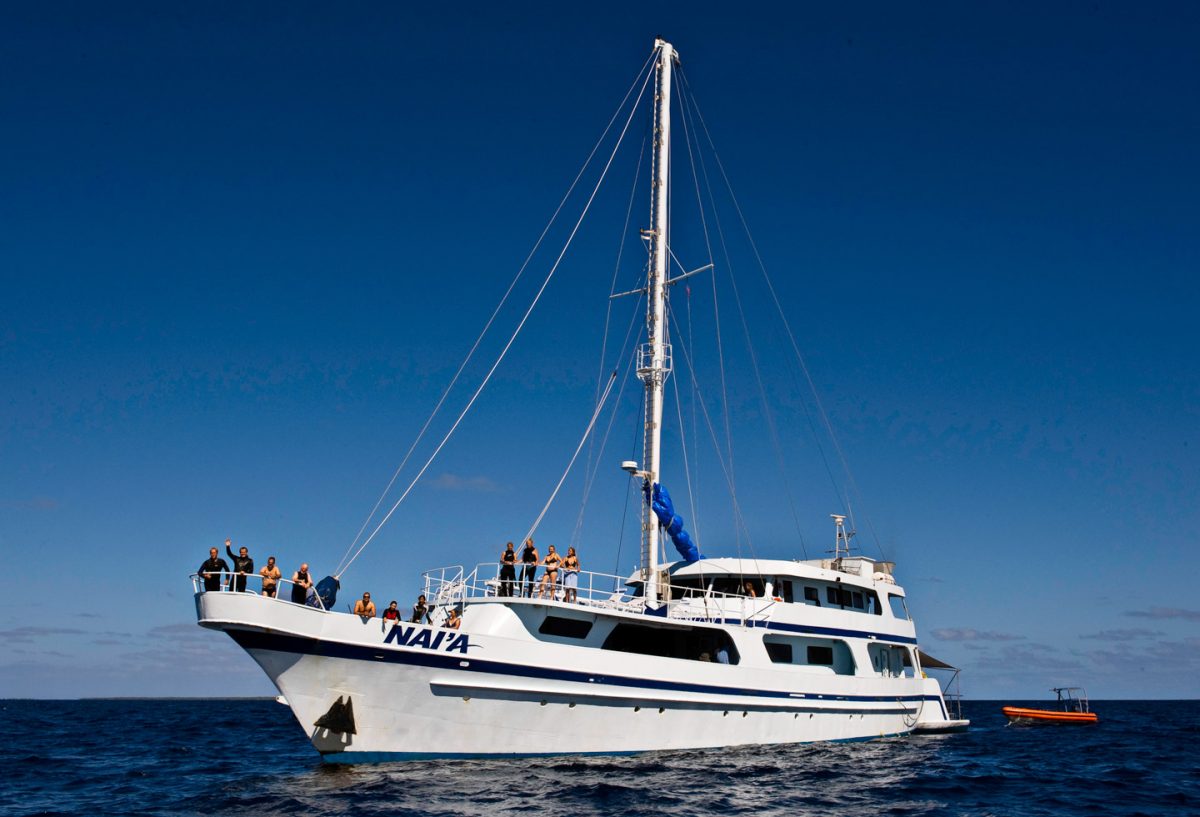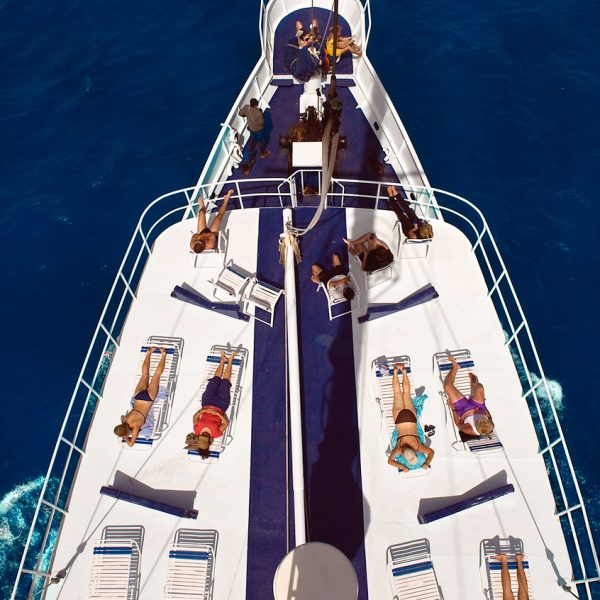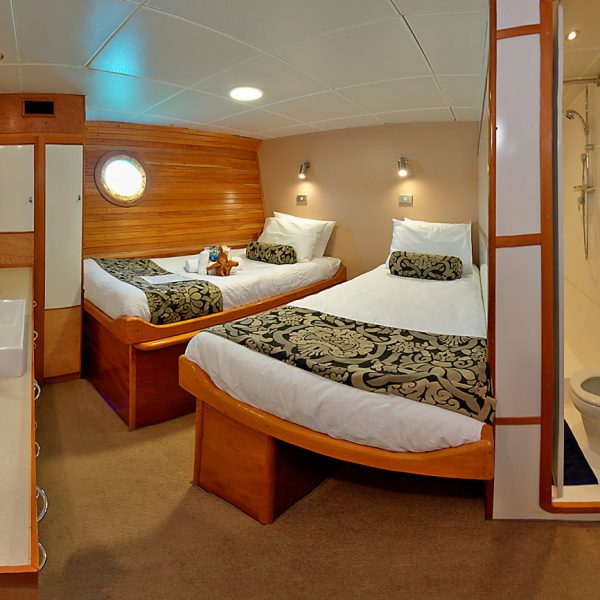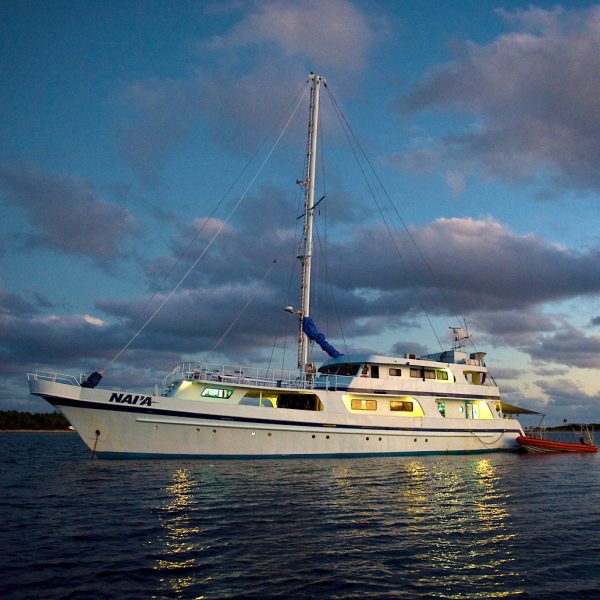Accommodations
NAI’A has accommodation for 18 passengers in 9 air-conditioned staterooms with private ensuite heads. Three of the staterooms have king-size beds that can be configured as individual singles; two of the staterooms have both a king and a single bunk above at the foot; two staterooms have only a king bed; and two staterooms have twin bunk beds. All the staterooms are larger than those on most dive vessels, with plenty of stowage for gear, and they are bright, airy, and comfortable. While camera and strobe charging is best done in the camera room, each room has both 110 and 220 volt power to run whatever electrical goodies you have.
Dining
Delicious and beautifully prepared meals of locally grown produce and meats and fresh fish await the hungry diver with a widely varied parade of delights served from the galley of our chefs.
Amenities
Nai’a’s main salon is perhaps her most eye-catching feature. Carefully crafted out of local timbers, the 625 square foot room serves as lounge, theater, classroom, and dining room. The four tables in the salon are showpiece items, built as a gift to NAI’A by the Fijian carpenters who refinished the ship. Made of alternating planks of the four native timbers used elsewhere throughout the ship, the tables are polished to a high sheen.
When you come back from the dive you can review your videos immediately using the entertainment system located in the salon. Two DVD players are wired to the Sony High Definition television and there are extra jacks with which to plug in your own camera. The salon is also a comfortable place to just sit and relax, read a book or take a nap. There is an extensive library of interesting books, magazines, games and puzzles available for your use while onboard. For those who want to be outside in the sun, the whole roof area over the dive deck and the camera room is a sundeck open to undiluted rays. This is a great place to enjoy a relaxing lunch while working on your tan. For the enthusiastic, this area turns into a great workout space. If you are more interested in simple relaxation, there are plenty of comfortable lounge chairs. The crow’s nest on the mast, fifty feet above the water, is the ideal spot from which to guide the ship through the narrow passages common to Fiji’s outlying islands and from which to yell the traditional “thar she blows” when sighting a whale. The pulpit over the bow is another great place to lounge. It’s roomy enough for six to sit or a dozen excited people can stand watching bow-riding dolphins or breaching whales. When cool ocean breezes are blowing, this is the place to be! Protected from the wind and exposed to the sun, this is a great place to get away from it all and enjoy some time alone. Did someone yell, “dolphins”? That word can wake you up from an afternoon nap in a split second. And this is where you’ll want to be ready with your camera in hand when it happens.
Diving
Central Fiji has the best diving, no doubt about it. This “NAI’A Triangle” of Lomaiviti, Bligh Water and Namena is the focus of the regular itineraries, covering about 500 nautical miles. NAI’A has journeyed throughout Fiji, in all directions and to every corner of the country’s boundaries — and beyond. Beautiful sites and dramatic attractions have been found in every region and they still explore new places. But the central region has proved the most consistent in the quality and health of terrains, animals and conditions. Lomaiviti’s coral reefs and islands are Fiji’s most dynamic and varied: voracious sharks to vibrant soft corals. Fiji’s coral reef system is a complex web of barrier reefs surrounding large lagoons and islands. Coral growth and fish action are most robust on those outer barrier reefs. Marine life is especially concentrated within the reef passages and channels that link the lagoons with the deep ocean. But the barrier reefs are remote and vast – a long way from shore bases – so only the best-equipped live-aboard diving vessels can access these locations. Much of the area remains uncharted and the dive sites untouched. All this makes NAI’A dive sites in the NAI’A Triangle of Lomaiviti, Namena and Bligh Water largely exclusive. You are extremely unlikely to encounter another dive boat during a NAI’A trip — it will feel like your own private pristine Fiji.
Itinerary Information
The normal itinerary for both seven and ten-day charters starts and ends in Lautoka, just north of Nadi, where the international airport is located. After an initial “checkout” dive on the afternoon of boarding, NAI’A heads north and east around the flank of the main island of Viti Levu to reach Bligh Water. Several different dive sites in Bligh Water are available including Vatu-i-ra, E6, Mt.Mutiny, and Cat’s Meow, depending on localized weather conditions. From there the sites are chosen according to weather, tides, and the passengers’ inclinations. But generally you’ll visit the islands and barrier reefs of Namena, Wakaya, and Gau. On ten-day charters there is more time available to dive the various reefs in the KoroSea, some of them near Namena and others near nowhere!
Sharks
Fiji is fortunate that sharks here are less preyed upon than in most other countries. The reefs that NAI’A dives have good populations of white-tip, hammerhead and grey reef sharks. Black-tip, tiger, bull, nurse, and silver-tip sharks are not uncommon, but you have to be lucky to see one. They’re shy. White-tips and gray reef sharks are pretty much everywhere and the most reliable sites for hammerheads are the offshore seamounts of Mt.Mutiny and E-6, as well as the Namena Marine Reserve and Wakaya.
Diving Logistics
Just between the salon and the camera room is the spacious dive deck. The dive deck on NAI’A is unconventional in several respects. First, it is huge, bridging the entire 30ft beam of the ship, and it is located away from the clutter of the working deck aft. During the charter, the crew takes care of filling the tanks and loading gear into the skiffs from the aft dive platform, while divers have the uncluttered dive deck forward in which to suit up and listen to the very thorough dive briefings. Only masks, fins, and camera gear are stored forward, while the heavy and unwieldy tanks and BCs remain aft. Divers returning to the dive deck are treated to hot deck showers and clean dry towels at the end of every dive. NAI’A has a small laundry aboard where towels and tablecloths are washed daily. Once the scuba tanks have been moved aft at the start of the charter, the dive deck cushions come out and the place becomes a lounging area sheltered from the midday sun. When its time to dive you’ll find your skiff waiting at the back dive deck. The crew takes care of moving your gear and making sure your tanks are full so you don’t have to. After the dive you simply step out of the skiff onto the back deck and the crew will do the rest! NAI’A uses two 22ft rigid inflatables. These are robust boats and their low freeboard makes them easy to exit and enter. Because NAI’A uses two skiffs, divers who surface early are whisked back to the ship where they can have a shower and a brownie while they wait for the hard-core macro photographers to complete their dive.
Camera Room
After each dive you can rinse your camera gear in the two large fresh water dip tanks. Compressed air is at your fingertips in the camera room for cleaning and drying parts. The camera room is located immediately adjacent to the dive deck and has storage and work space for more than a dozen photographers, their gear and storage of cases. Both 110 and 220 volt charging strips are available. There are more than enough for everyone! NAI’A features the latest provisions for professional and amateur photographers in this digital age: a computer charging and storage console in the salon and a giant flat-screen High Definition TV.
Village Visit
Over the years, NAI’A has established relationships with several villages on isolated islands. It started in 1994, when the chief of Gau (the “Takalaigau”) first invited NAI’A’s passengers to visit ashore, and the village visit near the end of the charter has become one of the highlights, even for people who came to Fiji intent only on diving as much as humanly possible. The reason: Fijians are the friendliest people on earth and a visit ashore is like being invited home by a new friend — multiplied by the 50 or more villagers who normally turn out to welcome you. They are honored to have their village visited, where there is no hint of commercialization, and they are somewhat in awe that people would travel all the way from across the world to dive on their reefs. Most of the passengers who return for their second or third visit come back in part to go back to see their friends in the village.
Before you go ashore, there will be a “village briefing” that explains what to expect and what not to do. Don’t wear a hat or sunglasses, don’t pat the kids on the head (this is almost impossible to resist: they’re so cute!), don’t point your feet at the yaqona bowl or at the chief, and be sure to wear shorts under your sulu in case if falls off. Among the complementary gifts you’ll find in your stateroom when you arrive is a sulu, which is mandatory for the village and awfully comfortable the rest of the time, too. Wearing it to dinner a few nights before the village visit helps ensure that you learn how to tie it successfully….
The visit includes a stroll through the village before enjoying a gathering in the large meeting hall. The villagers love to have their pictures taken. You will take part in a traditional kava ceremony. Kava is made from Yaqona, which is made from the pounded roots of a pepper plant. Good stuff is at least three years old, fine quality is six years old, and the twelve year old stash is saved for special occasions. People claim that yaqona tastes and looks a bit like dirty dishwater. The effects are mildly euphoric.
The village children, or the old women, or sometimes the young men will put on a meke: a traditional song and dance which tells a bit of the history of the place. A capable, extraordinary sailing vessel, NAI’A can comfortably reach the Pacific’s most remote and pristine coral reefs and delivers a truly unique and exceptional Fijian vacation.











